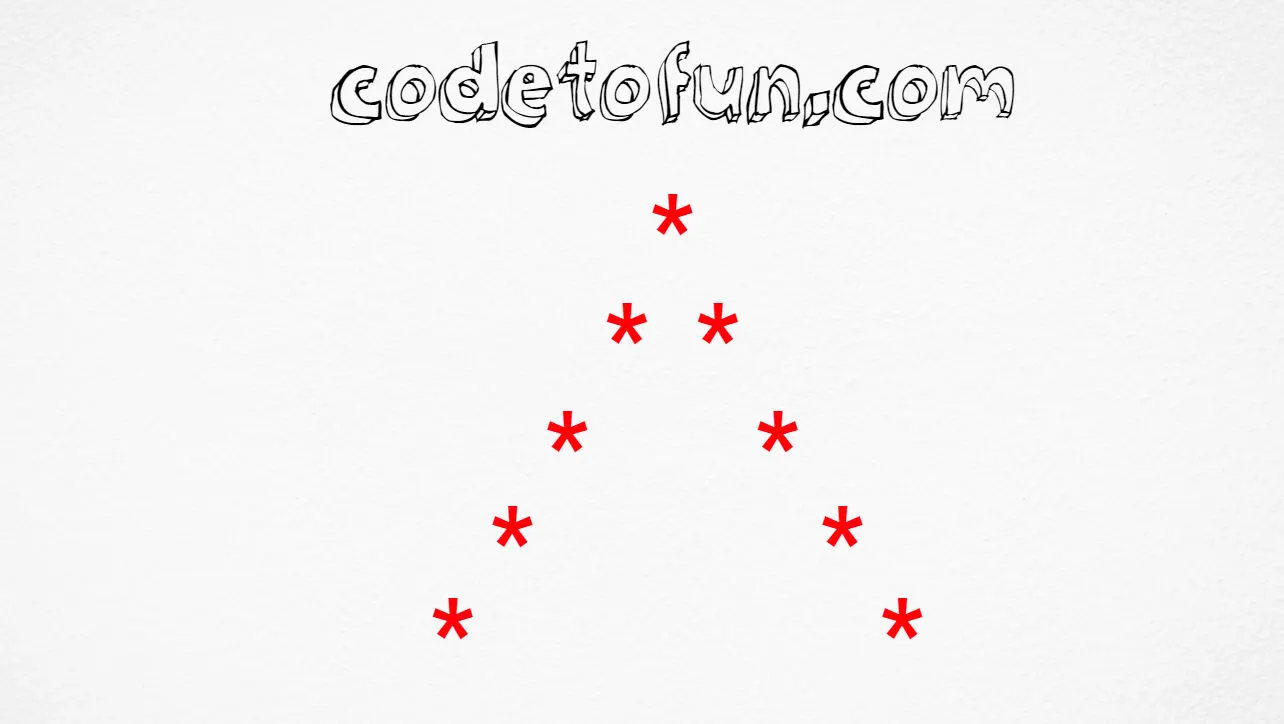
C Star Pattern 7

Photo Credit to CodeToFun
C Star Pattern 7
The above star pattern is called Half hollow diamond pattern.
📄 Example
Here's a program that prints the above star pattern using C Programming:
#include <stdio.h>
int main()
{
int i, j, k;
for(i=1; i<=5; i++)
{
for(j=5; j>=1; j--)
{
if(i == j)
printf("*");
else
printf(" ");
}
for(k=2; k<=5; k++)
{
if(i == k)
printf("*");
else
printf(" ");
}
printf("\n");
}
return 0;
}
💻 Testing the Program
When you run the program, it will print the following pattern:
*
* *
* *
* *
* *
🧠 How the Program Works
Let's break down the logic behind the code:
- The program starts with the main() function declaration.
- It includes the necessary header file stdio.h for standard input/output operations.
- Three integer variables i, j, and k are declared to control the loops and track the current row and column.
- The outer loop for(i=1; i<=5; i++) is used to iterate over the rows. It runs for i values from 1 to 5 (inclusive).
- Inside the outer loop, the first inner loop for(j=5; j>=1; j--) is used to print spaces or asterisks in a decreasing manner from right to left. It runs for j values from 5 to 1 (inclusive).
- If the current row i is equal to the current column j, it means we are in the position to print an asterisk in the pattern. So, if(i == j) condition is checked, and if true, an asterisk is printed.
- If the current row i is not equal to the current column j, it means we need to print a space in that position. So, the else block is executed, and a space is printed.
- After the first inner loop, a second inner loop for(k=2; k<=5; k++) is used to print spaces or asterisks in an increasing manner from left to right. It runs for k values from 2 to 5 (inclusive).
- If the current row i is equal to the current column k, it means we are in the position to print an asterisk in the pattern. So, if(i == k) condition is checked, and if true, an asterisk is printed.
- If the current row i is not equal to the current column k, it means we need to print a space in that position. So, the else block is executed, and a space is printed.
- After both inner loops, a newline character is printed using printf("\n") to move to the next line before starting the next row.
- The outer loop repeats steps 5 to 7 for each row of the pattern.
- Finally, the main() function returns 0 to indicate successful program execution.
The program uses the concept of nested loops to control the row and column positions and conditional statements to determine whether to print an asterisk or a space in each position. The combination of these loops and conditions creates the desired pattern.
💯 Tips for Enhancement:
Explore the versatility of this pattern by adjusting its parameters. Whether you increase or decrease the size, tweak the spacing, or modify the characters used, each change opens up a world of possibilities, allowing you to customize and create your unique visual effects.
✔ Conclusion:
Creating visually appealing patterns is not only a fun endeavour but also a great way to enhance your programming or design skills. We hope this tutorial has inspired you to explore the world of creative coding. Share your creations with us, and let your imagination run wild!
🤗 Closing Call-to-Action:
We'd love to see your unique interpretations of the star pattern. Share your creations in the comments below, and don't hesitate to reach out if you have any questions or suggestions for future tutorials. Happy coding!
👨💻 Join our Community:
Author

For over eight years, I worked as a full-stack web developer. Now, I have chosen my profession as a full-time blogger at codetofun.com.
Buy me a coffee to make codetofun.com free for everyone.
Buy me a Coffee












If you have any doubts regarding this article (C Star Pattern 7) please comment here. I will help you immediately.